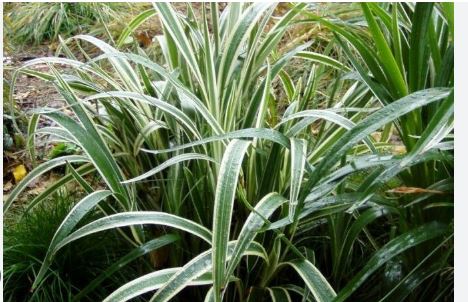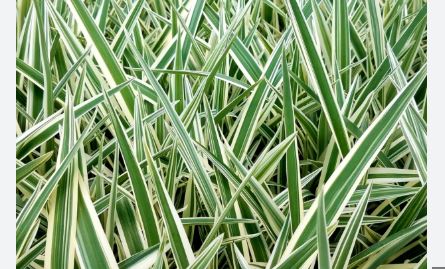
Flax lily, scientifically known as Dianella tasmanica, belongs to the Asphodelaceae family, within the subfamily Hemerocallidoideae, a group of monocots that includes other strap-leaved perennials like daylilies. The genus Dianella comprises about 40 species, mostly native to Australia, and is named after Diana, the Roman goddess, reflecting the plant’s graceful beauty. The species name “tasmanica” indicates its strong association with Tasmania, though it grows elsewhere. Previously placed in the Liliaceae or Phormiaceae families, its current classification aligns it with xerophytic plants adapted to diverse climates, distinguishing it from true lilies despite its common name.
Dianella tasmanica is an evergreen, clump-forming perennial, growing 1–3 feet (30–90 cm) tall and 1–2 feet (30–60 cm) wide, with a rhizomatous root system. Its strap-like, arching leaves are tough, linear, and deep green, measuring 12–30 inches (30–75 cm) long and 0.5–1 inch (1.3–2.5 cm) wide, sometimes with a bluish tint or variegated in cultivars like ‘Variegata’. In spring to summer, delicate, nodding, star-shaped flowers, 0.5 inch (1.3 cm) wide, bloom on slender, branched panicles above the foliage, displaying vibrant blue petals with yellow anthers. These give way to glossy, blue-purple berries, 0.3–0.5 inch (0.8–1.3 cm) long, persisting into fall. Its tidy, grass-like form and colorful accents make it visually appealing year-round.
Flax lily is native to southeastern Australia, primarily Tasmania, Victoria, and parts of New South Wales, where it thrives in eucalyptus forests, woodlands, and coastal heathlands. It grows in a range of soils, from sandy loams to clay, often in shaded or semi-shaded understories. Due to its ornamental value, it has been widely cultivated beyond Australia, popular in the United States (especially California and the Southeast), New Zealand, and Mediterranean climates. It is not invasive but has naturalized in some garden settings, particularly in mild, frost-free regions where its berries are spread by birds.
Dianella tasmanica is hardy in USDA zones 8b–11, tolerating temperatures as low as 15°F (-9°C) for short periods, though prolonged cold may damage foliage. It thrives in temperate to subtropical climates with temperatures between 50°F and 85°F (10°C–29°C), ideal for coastal and inland gardens. In zones 8b–9a, it benefits from winter protection, such as mulch, to shield roots. In colder zones (below 8b), it can be grown in containers and brought indoors during winter, adapting well to indoor conditions with bright, indirect light and minimal watering.
Flax lily is a versatile plant in landscaping, valued for its lush foliage, vibrant berries, and low-maintenance nature. Its clumping habit makes it ideal for borders, mass plantings, or groundcovers in shaded or semi-shaded gardens, where it adds texture under trees or shrubs. It excels in coastal, Mediterranean, or native gardens, tolerating drought and salt spray once established. As an accent in rock gardens, near water features, or in mixed perennial beds, its blue flowers and berries provide seasonal color. In containers, it enhances patios or balconies, especially variegated cultivars for visual contrast. Its deer resistance and ability to stabilize slopes make it practical, though berries should be kept from pets or children due to mild toxicity.

How To Grow And Care For Flax lily (Dianella tasmanica)
Cultivating Flax lily (Dianella tasmanica) is rewarding due to its attractive foliage, vibrant flowers, and low-maintenance nature.
Light Requirements
Provide partial shade to full shade, with 2–4 hours of filtered sunlight or morning sun ideal for healthy growth and vivid leaf color. In cooler climates, it tolerates full sun, but intense afternoon sun in hot regions can scorch leaves. Indoors, place near an east-facing window or under grow lights to mimic its preferred dappled light conditions.
Soil Preferences
Plant in well-draining, slightly acidic to neutral soil (pH 5.5–7.0), such as sandy loam or enriched garden soil. Incorporate organic matter like compost to improve fertility and structure, but avoid heavy clay that retains water. For containers, use a standard potting mix with added perlite to ensure drainage and prevent root rot.
Watering Needs
Water regularly during the first year to establish roots, keeping soil consistently moist but not soggy, about 1 inch (2.5 cm) weekly. Once established, water every 10–14 days in summer, allowing soil to dry slightly between waterings, and reduce in winter. Overwatering causes yellowing leaves, so check soil moisture before watering to avoid excess.
Temperature Range
Grow in USDA zones 8b–11, where temperatures range from 15°F to 85°F (-9°C to 29°C). It tolerates brief cold snaps but may suffer foliage damage below 20°F (-6°C); mulch roots in zones 8b–9a for protection. In colder zones, cultivate in pots and move indoors during winter, maintaining 50°F (10°C) or higher with minimal water.
Humidity Levels
Flax lily thrives in moderate humidity (40–60%), typical of coastal or woodland settings. It adapts to lower humidity but benefits from occasional misting indoors in dry conditions, especially during winter heating. Ensure good air circulation to prevent fungal issues, avoiding overly humid, stagnant environments.
Container Selection
Choose pots with drainage holes to prevent water buildup. Plastic or ceramic pots work well, at least 12–16 inches (30–40 cm) wide to accommodate clumping roots. Ensure the container supports its spreading habit, repotting every 2–3 years to refresh soil and provide space for rhizome expansion.
Fertilization
Apply a balanced, slow-release fertilizer (e.g., 10-10-10 NPK) in early spring to boost growth and flowering. Alternatively, use a diluted liquid fertilizer monthly during spring–summer. Avoid over-fertilizing, as excess nutrients cause lush foliage at the expense of flowers or berries; skip feeding in fall and winter.
Pruning
Trim dead, damaged, or yellowing leaves in late winter or early spring to maintain a tidy appearance, using clean shears to cut at the base. Remove spent flower stalks after berries drop to encourage new growth. Light pruning every 2–3 years rejuvenates dense clumps, but avoid heavy cutting to preserve the plant’s natural form.
Propagation
Propagate by division or seeds. Divide clumps in spring, separating rhizomes with healthy shoots and replanting in moist soil; new growth appears in 4–6 weeks. Seeds, sown in a well-draining mix at 65–75°F (18–24°C), germinate in 4–8 weeks but are slower to mature. Division is preferred for quicker results and true-to-type plants.
Pest Control
Monitor for pests like aphids, scale, or spider mites, which may affect stressed plants. Inspect leaves regularly, treating infestations with insecticidal soap or neem oil, applied in early morning. Maintain proper watering and avoid overcrowding to enhance resilience, as healthy Flax lilies are less prone to pest issues.
Repotting
Repot every 2–3 years in spring, or when roots outgrow the container. Gently remove the plant, shake off old soil, and divide clumps if desired before replanting in fresh potting mix. Water lightly after repotting and keep in partial shade for a week to reduce transplant shock, ensuring excellent drainage.
Winter Care
In zones 8b–9a, mulch around the base with 2 inches (5 cm) of organic material to insulate roots during cold snaps. If foliage browns after frost, wait until spring to trim, as roots often survive. Indoor plants require bright, indirect light, cool temperatures (50–60°F/10–16°C), and reduced watering to mimic dormancy.
Common Issues
Address overwatering (yellow leaves, root rot) by improving drainage and reducing frequency. Underwatering (drooping, dry leaves) requires slight watering increases. Poor flowering often indicates too much shade or excess nitrogen; adjust light exposure or fertilizer. Leaf burn from direct sun can be mitigated by relocating to shadier spots in hot climates.